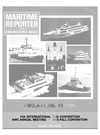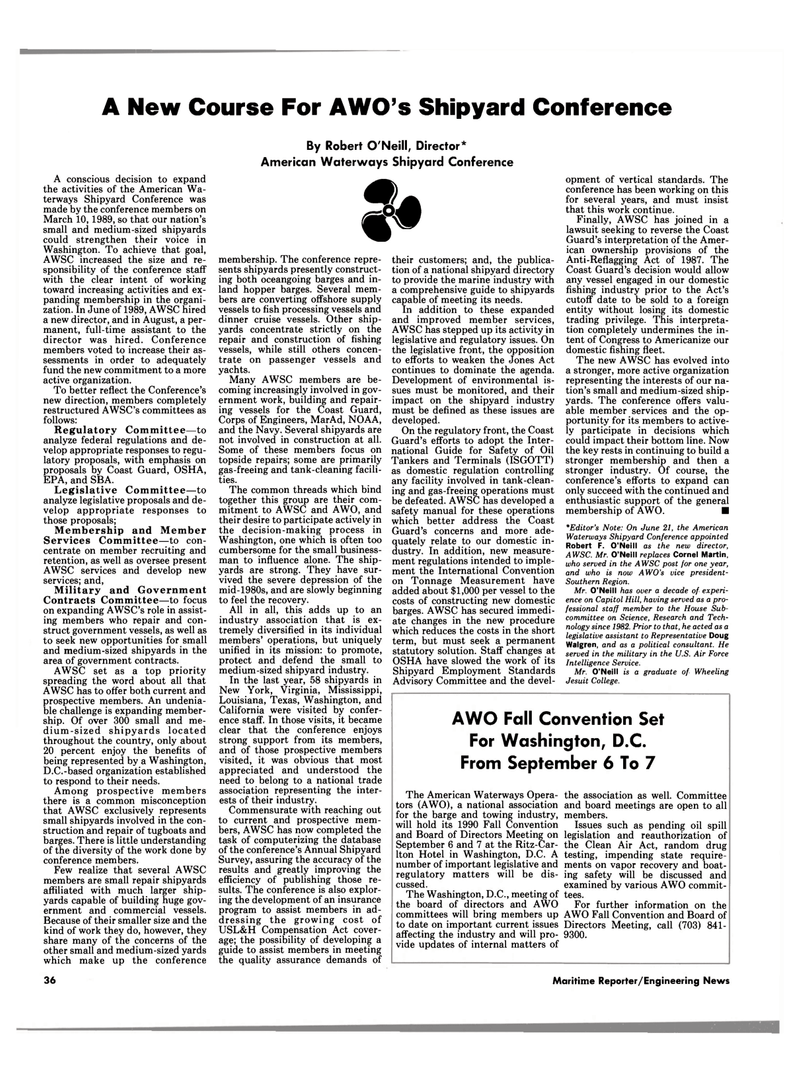
Page 36: of Maritime Reporter Magazine (August 1990)
Read this page in Pdf, Flash or Html5 edition of August 1990 Maritime Reporter Magazine
A New Course For AWO's Shipyard Conference
By Robert O'Neill, Director*
American Waterways Shipyard Conference J§
A conscious decision to expand the activities of the American Wa- terways Shipyard Conference was made by the conference members on
March 10, 1989, so that our nation's small and medium-sized shipyards could strengthen their voice in
Washington. To achieve that goal,
AWSC increased the size and re- sponsibility of the conference staff with the clear intent of working toward increasing activities and ex- panding membership in the organi- zation. In June of 1989, AWSC hired a new director, and in August, a per- manent, full-time assistant to the director was hired. Conference members voted to increase their as- sessments in order to adequately fund the new commitment to a more active organization.
To better reflect the Conference's new direction, members completely restructured AWSC's committees as follows:
Regulatory Committee—to analyze federal regulations and de- velop appropriate responses to regu- latory proposals, with emphasis on proposals by Coast Guard, OSHA,
EPA, and SBA.
Legislative Committee—to analyze legislative proposals and de- velop appropriate responses to those proposals;
Membership and Member
Services Committee—to con- centrate on member recruiting and retention, as well as oversee present
AWSC services and develop new services; and,
Military and Government
Contracts Committee—to focus on expanding AWSC's role in assist- ing members who repair and con- struct government vessels, as well as to seek new opportunities for small and medium-sized shipyards in the area of government contracts.
AWSC set as a top priority spreading the word about all that
AWSC has to offer both current and prospective members. An undenia- ble challenge is expanding member- ship. Of over 300 small and me- dium-sized shipyards located throughout the country, only about 20 percent enjoy the benefits of being represented by a Washington,
D.C.-based organization established to respond to their needs.
Among prospective members there is a common misconception that AWSC exclusively represents small shipyards involved in the con- struction and repair of tugboats and barges. There is little understanding of the diversity of the work done by conference members.
Few realize that several AWSC members are small repair shipyards affiliated with much larger ship- yards capable of building huge gov- ernment and commercial vessels.
Because of their smaller size and the kind of work they do, however, they share many of the concerns of the other small and medium-sized yards which make up the conference membership. The conference repre- sents shipyards presently construct- ing both oceangoing barges and in- land hopper barges. Several mem- bers are converting offshore supply vessels to fish processing vessels and dinner cruise vessels. Other ship- yards concentrate strictly on the repair and construction of fishing vessels, while still others concen- trate on passenger vessels and yachts.
Many AWSC members are be- coming increasingly involved in gov- ernment work, building and repair- ing vessels for the Coast Guard,
Corps of Engineers, MarAd, NOAA, and the Navy. Several shipyards are not involved in construction at all.
Some of these members focus on topside repairs; some are primarily gas-freeing and tank-cleaning facili- ties.
The common threads which bind together this group are their com- mitment to AWSC and AWO, and their desire to participate actively in the decision-making process in
Washington, one which is often too cumbersome for the small business- man to influence alone. The ship- yards are strong. They have sur- vived the severe depression of the mid-1980s, and are slowly beginning to feel the recovery.
All in all, this adds up to an industry association that is ex- tremely diversified in its individual members' operations, but uniquely unified in its mission: to promote, protect and defend the small to medium-sized shipyard industry.
In the last year, 58 shipyards in
New York, Virginia, Mississippi,
Louisiana, Texas, Washington, and
California were visited by confer- ence staff. In those visits, it became clear that the conference enjoys strong support from its members, and of those prospective members visited, it was obvious that most appreciated and understood the need to belong to a national trade association representing the inter- ests of their industry.
Commensurate with reaching out to current and prospective mem- bers, AWSC has now completed the task of computerizing the database of the conference's Annual Shipyard
Survey, assuring the accuracy of the results and greatly improving the efficiency of publishing those re- sults. The conference is also explor- ing the development of an insurance program to assist members in ad- dressing the growing cost of
USL&H Compensation Act cover- age; the possibility of developing a guide to assist members in meeting the quality assurance demands of their customers; and, the publica- tion of a national shipyard directory to provide the marine industry with a comprehensive guide to shipyards capable of meeting its needs.
In addition to these expanded and improved member services,
AWSC has stepped up its activity in legislative and regulatory issues. On the legislative front, the opposition to efforts to weaken the Jones Act continues to dominate the agenda.
Development of environmental is- sues must be monitored, and their impact on the shipyard industry must be defined as these issues are developed.
On the regulatory front, the Coast
Guard's efforts to adopt the Inter- national Guide for Safety of Oil
Tankers and Terminals (ISGOTT) as domestic regulation controlling any facility involved in tank-clean- ing and gas-freeing operations must be defeated. AWSC has developed a safety manual for these operations which better address the Coast
Guard's concerns and more ade- quately relate to our domestic in- dustry. In addition, new measure- ment regulations intended to imple- ment the International Convention on Tonnage Measurement have added about $1,000 per vessel to the costs of constructing new domestic barges. AWSC has secured immedi- ate changes in the new procedure which reduces the costs in the short term, but must seek a permanent statutory solution. Staff changes at
OSHA have slowed the work of its
Shipyard Employment Standards
Advisory Committee and the devel- opment of vertical standards. The conference has been working on this for several years, and must insist that this work continue.
Finally, AWSC has joined in a lawsuit seeking to reverse the Coast
Guard's interpretation of the Amer- ican ownership provisions of the
Anti-Reflagging Act of 1987. The
Coast Guard's decision would allow any vessel engaged in our domestic fishing industry prior to the Act's cutoff date to be sold to a foreign entity without losing its domestic trading privilege. This interpreta- tion completely undermines the in- tent of Congress to Americanize our domestic fishing fleet.
The new AWSC has evolved into a stronger, more active organization representing the interests of our na- tion's small and medium-sized ship- yards. The conference offers valu- able member services and the op- portunity for its members to active- ly participate in decisions which could impact their bottom line. Now the key rests in continuing to build a stronger membership and then a stronger industry. Of course, the conference's efforts to expand can only succeed with the continued and enthusiastic support of the general membership of AWO. • *Editor's Note: On June 21, the American
Waterways Shipyard Conference appointed
Robert F. O'Neill as the new director,
AtVSC. Mr. O'Neill replaces Cornel Martin. who served in the AWSC post for one year, and who is now AWO's vice president-
Southern Region.
Mr. O'Neill has over a decade of experi- ence on Capitol Hill, having served as a pro- fessional staff member to the House Sub- committee on Science, Research and Tech- nology since 1982. Prior to that, he acted as a legislative assistant to Representative Doug
Walgren, and as a political consultant. He served in the military in the U.S. Air Force
Intelligence Service.
Mr. O'Neill is a graduate of Wheeling
Jesuit College.
AWO Fall Convention Set
For Washington, D.C.
From September 6 To 7
The American Waterways Opera- the association as well. Committee tors (AWO), a national association and board meetings are open to all for the barge and towing industry, members. will hold its 1990 Fall Convention Issues such as pending oil spill and Board of Directors Meeting on legislation and reauthorization of
September 6 and 7 at the Ritz-Car- the Clean Air Act, random drug lton Hotel in Washington, D.C. A testing, impending state require- number of important legislative and ments on vapor recovery and boat- regulatory matters will be dis- ing safety will be discussed and cussed. examined by various AWO commit-
The Washington, D.C., meeting of tees, the board of directors and AWO For further information on the committees will bring members up AWO Fall Convention and Board of to date on important current issues Directors Meeting, call (703) 841- affecting the industry and will pro- 9300. vide updates of internal matters of 36 Maritime Reporter/Engineering News

 35
35

 37
37
